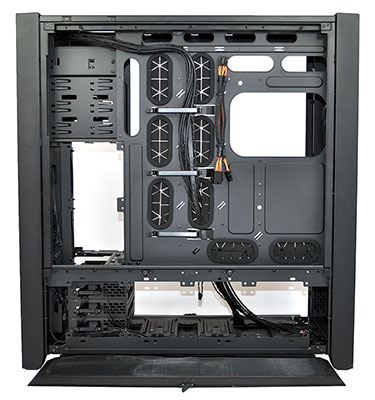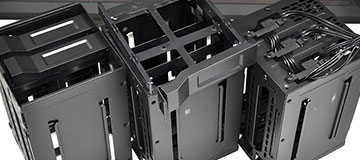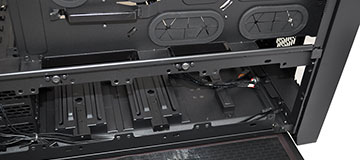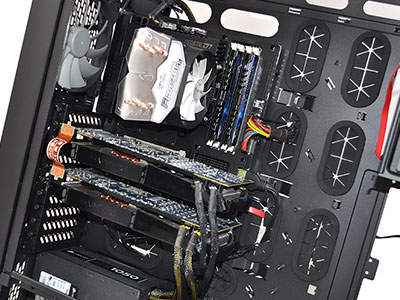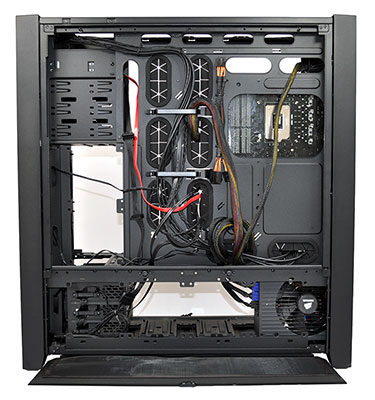Inside the Obsidian Series 900D
Step inside the 900D and it's difficult not to be impressed. The towering frame is designed to engulf high-end components, and no matter what you throw at it, there should be enough room in here to gobble up whatever extreme configurations you can come up with.
Where shall we start? There are four tool-free 5.25in optical bays (that's actually one fewer than the 800D), dual power supply bays, 10 expansion slots, and four fans included as standard - three 120mm front intakes (fan model AF120L) and a single 140mm rear exhaust (fan model AF140L). The chassis supports up to 15 fans in total, and if you're taking the air-cooled route you'll want to keep a high intake count in order to maintain positive air pressure. But, really, the 900D is crying out for some radiator love.
Here we go: the chassis can accommodate (up to) a 360mm radiator at the front, a 420/480mm radiator up top, a 120/140mm at the rear, a 420/480mm radiator on one lower side, and a 240/280mm radiator on the lower side that houses the PSU. There's an insane amount of liquid-cooling potential on offer here, and unless you're wielding a 560mm rad, you're unlikely to be left wanting by the 900D's numerous mounting points.
|
|||||||||||||||||||||||||||||||||||||||||||||||
Elsewhere, there are over a dozen cable-routing holes (eight of which are rubber-grommeted) and the raised position of the motherboard tray gives the user the opportunity to pass power supply cables directly up behind and out of sight.
Cable management, as you'd expect from an 800D successor, is outstanding, and there are plenty of useful touches throughout. The nine 2.5/3.5in storage bays, for example, are spread across a trio of modular cages that can be positioned in any of the five available mounts (three in the lower compartment, two by the front intakes).
Additional three-bay cages will be available to purchase separately - allowing the total capacity to be increased to 15 drives - but the nine provided bays should be ample for most users, and three of them have a useful trick up their sleeve. As pictured above, one of the modular cages is pre-plumbed for hot-swap capability. What's handy is that the hot-swap cage can be relocated to a position that suits you best (we prefer it in the lower compartment for easy access) and, unlike the 800D, the hot-swap bays are now entirely tool free.
There are helpful features throughout, but not everything is perfect. The plastic drive trays don't feel particularly strong and aren't befitting a chassis of this stature, and though we appreciate the fact that Corsair has brought over the cable clamps from the Vengeance C70, they too are plastic and structurally out of their depth. Only three of these clamps are included in the box, and it didn't take long for us to break one.
Corsair has borrowed some features from its lower-end range to bring the new Obsidian up to date, yet the size and layout of the 900D has introduced a few oddities. The front bezel, pictured right, is so wide that optical drives look completely out of place; they don't sit flush and greatly reduce the chassis' aesthetic appeal. The stereotypical 900D user may have the know-how to stealth the drive with an after-sale modification, but the out-the-box implementation really should have been better.
And the cast aluminium surrounds that bring extra rigidity to the chassis? They too pose an unexpected hindrance as the rear surround overlaps the motherboard tray by a couple of inches, making it difficult to reach the expansion-slot thumbscrews with a normal screwdriver; Corsair includes a short Phillips-head Allen key in order to get around this very issue.
At times, the 900D doesn't feel quite as intuitive and easy going as its predecessor. But then, it does offer far greater potential.
In addition to supporting ATX and E-ATX motherboards, the 900D 'Super Tower' will also gratefully accept HPTX boards such as EVGA's Classified SR-X. On top of your dual CPUs you could quite easily fit quad GPUs, liquid cooling from five separate radiators, two power supplies, an optical drive, a 5.25in fan controller, nine hard disks and at least a dozen fans.
There aren't many chassis that offer this amount of flexibility (we're struggling to think of even one) and, while these dream machines are out of reach for most consumers, the 900D ultimately enables system integrators to sell PCs priced anywhere up to $10,000.
The size of the beast is such that it demands an extravagant ensemble of ultra-high-end kit. We've previously labelled our overclocked Ivy Bridge test platform as 'high-end,' but heck, even with its dual Radeon HD 7950 GPUs, it's practically lost inside the 900D.
Maintaining a clean-looking build is extremely easy; however without the right components the 900D can be left feeling sparse and empty. It really needs a couple of radiators, a large motherboard and multiple Titans in order to do it justice; so bear that in mind when you're gathering funds.
What can we take away from our internal and external overview? Well, it's clear that the Obsidian Series 900D isn't designed for the vast majority of PC users. Throwing caution to the wind, Corsair's new flagship is aimed specifically at those select few who want to take thousands of pounds worth of hardware and liquid cool the heck out of it.







